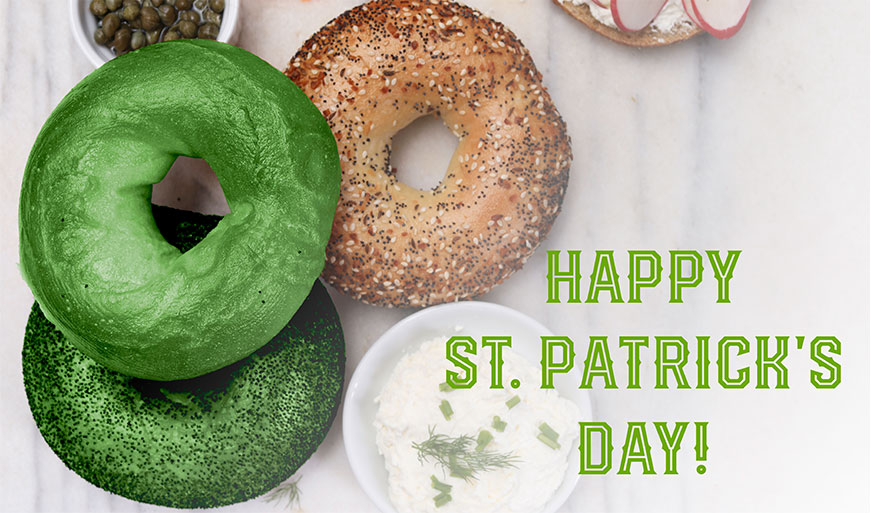Posted by Liz Trondsen
While the most popular way to celebrate St. Patrick’s Day is by wearing something green, some people get extra festive by eating something green too. From beer, to milkshakes, donuts and even bagels, there’s no mistaking that green food is abundant around March 17th. But, what actually makes that food green? And, is it healthy? We asked the experts and got a golden answer.
What Are Food Dyes?
Let’s face it, we like colorful food. Imagine our cereals, yogurts, birthday cakes and sport drinks without the bright pink, purple, blue and of course, green hues to which we are all accustomed. But, what is actually making our food colorful? .
According to the Food and Drug Administration (FDA), “a color additive (also known as food dye) is any dye, pigment, or other substance that can impart color to a food, drug, or cosmetic or to the human body. Color additives are important components of many products, making them attractive, appealing, appetizing, and informative”. Originally, food dyes were made from coal tar; today, most food-grade dyes are made from petroleum.
Food coloring may also come natural sources, such as vegetables and plants–dehydrated beets, spinach, saffron, or grape skin extract, for example. Whether artificial or natural, all color additives must be approved by the FDA before they may be used in foods. Approval includes restrictions on use, label identification language and ongoing testing and review. Food labels must also ist the names of any FDA-certified coloring (such as FD&C Blue No.1) while other colorings may be listed as “artificial colors” or “colors added.”
The Food and Drug Administration (FDA) is a government agency established in 1906; part of its mission is to be responsible “for the safety and security of most of our nation’s food supply.”
Don’t Food Dyes Cause Hyperactivity in Children?
In 1973, a pediatrician claimed that hyperactivity in children was caused by artificial food colorings and preservatives in food. Because of this claim, many families chose to avoid these products all together. Although no studies have shown that food colorings cause ADHD, there have been studies over the years that have shown a possible link between artificial food colorings and preservatives and hyperactivity in children, especially in children who are already hyperactive. While the FDA has disputed the conclusions of the above studies, it concludes, “the totality of scientific evidence indicates that most children have no adverse effects when consuming color additives, but some evidence suggests that certain children may be sensitive to them.”
Do Food Dyes Cause Cancer?
There is little agreement on this subject. First, it is important to note that the studies that have evaluated food dye safety were performed on animals; results from animal studies do not necessarily correlate to human beings. Secondly, studies have resulted in mixed conclusions. Any color additives that the FDA found to cause cancer in animals (or humans) are banned for use in the United States.
There may be some concern over possible contaminants in food dyes. The FDA has concluded that these contaminants are present in low levels, and consider the food colorings to be safe for consumption.
While the FDA believes that studies have not shown evidence that food colorings cause cancer, many of these studies were conducted years ago. As always, all parties agree that further research is needed.
Should I Avoid Food Dyes?
Despite assurances of safety from the FDA, there are still many people who are concerned about food dyes. Some dyes approved in the United States are banned in Europe, and many companies are working towards eliminating dyes from their products. For those who want to limit the amount of food coloring consumed, reducing the intake of processed foods will automatically lead to a reduction in the intake of artificial colorings.
If you want to eat green on St. Patrick’s Day,dtry naturally green foods, such as spinach, kale, avocado, broccoli, pesto or pistachio nuts. Adding spinach to your breakfast smoothie is like finding your pot of gold!
So, About That Bagel?
St. Patrick’s Day is once a year; enjoy a green bagel!
References
Becky Bell, MS, RD, Food Dyes: Harmless or Harmful? January, 2017.
FoodSafety.gov
Jill Kohn, MS, RDN, LDN, Food Additives and ADHD: Is There a Link? December 2017.
https://www.fda.gov/ForIndustry/ColorAdditives/default.htm
 ENGLISH
ENGLISH KOREAN
KOREAN Spanish
Spanish RUSSIAN
RUSSIAN Armenian
Armenian FILIPINO
FILIPINO Chinese (Simplified)
Chinese (Simplified) Chinese (Traditional)
Chinese (Traditional)

최신댓글